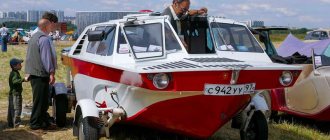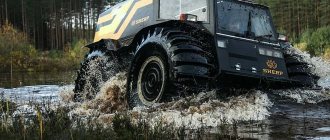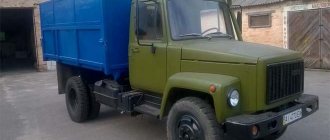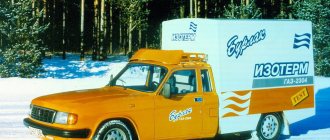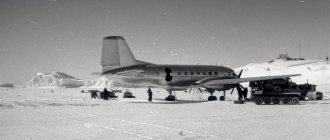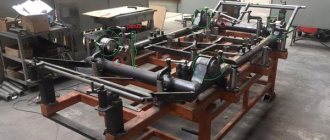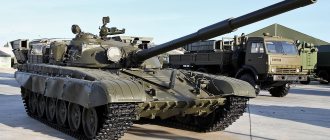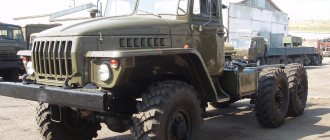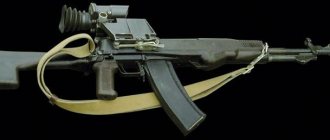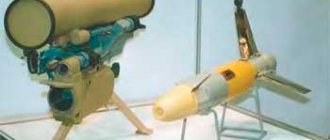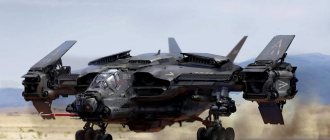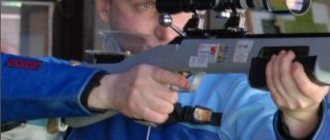Half-track all-terrain vehicles NATIHistory of the development of NATI-52 (ZIS-42)
G. Kryuchkov
Domestic cars developed in the late 20s looked archaic in pre-war times. However, they were sometimes better suited for use in harsh conditions than the latest foreign trucks of those years. At the same time, the Karakum motor rally, organized in 1933, revealed the complete inability of cars produced in the USSR to drive in off-road conditions.
During periods of spring and autumn thaw, dirt roads, on which 1.5 and 3-ton trucks would normally do well, became difficult to pass for any type of vehicle. In addition, snow drifts often made the movement of conventional vehicles completely impossible. In addition, in wartime conditions, driving even on pre-prepared roads involves the need to detour around destroyed sections of roads over rough terrain. Automobile transport of motorized units does not always have the opportunity to use even dirt roads of satisfactory quality. The military situation often forces the use of vehicles for off-road driving and virgin soil.
All-terrain wheeled vehicles with all drive wheels are mainly suitable for overcoming all types of dry off-road conditions. Severe off-road conditions (deep virgin snow, marshy areas, arable land and dirt roads washed away by long rains, as well as deep sand) make this technique practically helpless.
As you know, only vehicles with low specific ground pressure are suitable for driving on complete off-road conditions. Multi-axle wheeled all-terrain vehicles have good maneuverability, but the complexity of the transmission is a big disadvantage of such vehicles.
Of all land vehicles, tracked vehicles have the highest maneuverability. Tractors and transport tractors were developed in the 30s by the Union State Research and Experimental Automotive Institute (NATI) on the basis of conventional agricultural tractors, which were also designed within its walls. The idea of radically increasing the cross-country ability of mass-produced vehicles by creating a tracked propulsion system was tempting and seemed very promising.
The first example of a half-track propulsion unit was built in 1909 by a Frenchman, Adolf Kegresse, a mechanic at the Tsar’s garage, who proposed a propulsion unit with an endless rubber band for the Nepir passenger car. Then more advanced examples of the mechanism were installed on passenger cars “Packards” and “Russo-Balts”, and for the latter Kegress received a gold medal at the 1913 International Automobile Exhibition in St. Petersburg. After this, in 1916, engineer A. Krzhivitsky managed to place an order for 300 copies of Kegress propulsion systems for armored vehicles and trucks. The subsequent revolutions prevented the order from being completed (only 30 sets were made) and forced the Frenchman to leave for his homeland. There he improved the design by introducing metal linings with rubber shoes installed at the same pitch. On the inside of the belt, three rows of rubber-woven linings were fixed, of which the middle ones served as guides, and the outer ones engaged with the drive wheel.
In Soviet Russia, the Automotive Department of NATI worked on half-track vehicles starting in 1931. For this purpose, a special group was created, headed by G. A. Sonkin. After the first experiments with the half-tracked NAMI-2 passenger car and the Ford-AA car, which had a Kegress-type propulsion system, the NATI-3 truck was created in 1932 (the NATI-3 and Ford cars were also built NATI-5", which has an original propulsion system). The NATI all-terrain vehicle was created on the basis of the GAZ-AA truck, the production of which was established at the Nizhny Novgorod Automobile Plant in the same 1932.
A multiplier was added to the standard car's transmission, which has direct and overdrive gearing with a gear ratio of 0.7:1. The caterpillar movers, in contrast to the design based on the Ford AA, were mounted on elongated stockings of the rear axle axle shafts. Torque from the axle shafts was transmitted by Gall chains to the drive wheels with a gear ratio of 1.77:1. (Now the concept of “Gall chain” is not used, unlike the chains themselves, which can be found on various equipment, starting with a bicycle). The rubber-metal track was different from that used previously. She carried 68 metal shoes, half of which had flanges that served to guide the tape. The caterpillar was put on wheels and set in motion due to frictional engagement with the drive wheels or, simply put, friction. Its tension was ensured by a special mechanism. The propulsion system used specially profiled wheels without tread, inflated to a pressure of 2.75 atm. A special mechanism ensured the tension of Gall's chains, and a rubber cushion was fixed between the two levers.
The suspension design used standard springs, a cardan tube and unloading bars.
The front axle of the car remained standard, but provided for the installation of a double ramp. In the future, all half-track vehicles on GAZ chassis will have this design.
In 1933, an experimental half-track vehicle NATI-V appeared, which went into production the following year. Like its predecessor, it had a standard engine, only it was an M-1 engine, and not a GAZ-AA. It also developed 50 hp. at 2800 rpm. The number of gas tanks has increased to two. The upper tank had a volume of 40 liters, and the fuel flowed from it by gravity. The lower tank held 65 liters of fuel, which was supplied to the engine by a diaphragm fuel pump. The tank was installed under the floor of the cargo platform in its middle part. The fuel supply provided the vehicle with a 200-kilometer range.
The cooling system of the half-track vehicle has been modified. Instead of the standard four-row GAZ-AA radiator, a six-row GAZ-AAA radiator was installed on it. This upgrade increased the total cooling system capacity to 14.7 liters. Undoubtedly, the use of a larger radiator helped to improve the temperature conditions of the engine, which operates with a greater load at low vehicle speeds.
To protect against possible impacts when overcoming obstacles, the battery was moved and hung on a special bracket to the left longitudinal beam of the platform.
The front axle of the car and its suspension have changed. To improve cross-country ability, the bridge beam was hinged on a special bracket and had an elongated thrust square. This led to a change in the design of the car frame. Instead of its second cross member, a cross member was installed for fastening the thrust triangle of the front axle. The third cross member of the frame was also changed. It was turned with its flanges towards the rear axle, and a crossbar of the central brake was riveted to it. We installed a cross member behind the flywheel housing to secure the ball joint of the thrust fork.
Like its predecessor, the new all-terrain vehicle had a multiplier that reduced the gear ratio. To attach it to the frame, a special cross member was installed. The multiplier was a GAZ-AAA multiplier, with the input shaft facing the rear axle. Only the primary and secondary shafts and the front and rear covers of the unit were structurally changed.
In the truck's transmission, a soft cardan with a three-jaw fork was added to the Spicer-type universal joint. The engine torque was now transmitted through the axle shafts to the side differentials.
The caterpillar design has changed. A moving support roller was added to its tensioning mechanism. The slider carriage appeared.
The loading platform was installed 160 mm higher. This allowed the balance suspension of the propulsors to work better. For this purpose, the front transverse beam of the platform was shortened to the width of the tracks and reinforced with a metal square. With its own weight of 2800 kg, the car could carry 1200 kg of cargo.
In February–March 1935, the all-terrain vehicle took part in the Moscow–Arkhangelsk run. The technical commission came to the conclusion that the NATI-3 all-terrain vehicle has good maneuverability on various types of snowy off-road conditions. The insufficient speed of the car was explained by the low power of the GAZ-AA engine. In addition, when installing a more powerful engine, one could expect lower fuel consumption. The design was recognized as trouble-free and reliable. At the same time, there was insufficient rigidity of the frame, which should have been strengthened. The advantages of turning a standard car into an all-terrain vehicle were noted.
In 1938, when the Molotov Automobile Plant in the city of Gorky, as Nizhny Novgorod was then called, switched to the GAZ-MM model, a prototype of the NATI-GAZ 60 half-track vehicle was manufactured, which was put on the assembly line that same year. It was a modernized version of the all-terrain vehicle "B".
Changes affected the steering. The modified steering rods were manufactured according to the M-1 type. The front spring bracket was replaced with a more rigid one, made in the form of a casting. Instead of the elongated one, a standard front axle thrust fork was installed, and therefore the additional frame traverse was moved under the flywheel housing. The multiplier was removed from the car and an intermediate shaft was installed in its place.
The car also lost its front wheel brakes. Instead, on the central disc brake, in addition to two pads operating from manual control, two more pads with cast iron linings operating from foot control were additionally installed.
The rear axle axle shafts and their casings from the standard GAZ-AA vehicle with extensions added to them, used on the all-terrain vehicle model “B”, were replaced with special elongated axle shafts and casings with welded ends.
The modernization affected the design of the propulsion unit. The cast-iron split brackets of the propulsion frame gave way to a solid cast-iron hub. To increase the rigidity of the propulsion frames, the middle linings of the sidewalls were made with flanging. The eccentric device of the support roller, which serves to tension the track, was replaced with a mechanism with a screw and nut. The track roller stops were replaced with box-shaped ones, and therefore the attachment of the platform to the frame was changed.
Other changes were made. The additional gas tank was moved from under the middle of the body to the front. The metal battery box took place between the second and third bars of the platform.
In the same year, prototypes of half-track vehicles were built based on the Emka GAZ-M1 passenger car. The front wheel track was increased, and the original front axle was replaced with a tubular one. A GAZ-30 range-multiplier was added to the car's transmission. Installation of the caterpillar propulsion unit required replacing the rear axle with a redesigned GAZ-AA rear axle.
Later, in 1939, a rubber-metal tracked propulsion unit was installed on the GAZ-11. The car received the index B-11.
In 1936, the prototype NATI-V 3 was released. Developed by the team of the NATI Half-Tracked Vehicles Group, the propulsion unit found its place on the cars of the Moscow Automobile Plant named after Stalin: the ZIS-5 had a more powerful engine that developed 73 hp. at 2300 rpm, and was better suited for the role of an all-terrain vehicle. The design of the propulsion unit has not undergone any fundamental changes. As before, it consisted of a steel frame, at the ends of which double slopes of the front and rear drive wheels were installed in guides. In the middle part of the frame, a balancing carriage was installed on the axis, consisting of two cross beams with two support rollers. At the top, in the middle of the propulsion frame, a double support tension roller was attached to a bracket with eccentrics.
This entire part of the propeller assembly was mounted on a special casing of the stocking of the rear axle of the car. A side differential was installed on the outer end of a special drive axle. Gall chains were installed on the differential gears and the corresponding drive wheel gears. The chain drive ratio was 1.77:1. To protect the chains and gears from contamination, the propulsion frame was covered with a casing. The specific pressure of the caterpillar propulsion unit when submerged by 100 mm was 0.272 kg/cm2. Skis could be installed on the front wheels of the car for driving on snow. The specific pressure of the ski at the same immersion was 0.085 kg/cm2.
For the cooling system of the all-terrain vehicle "V 3", the radiator of the ZIS-6 car was borrowed, which increased the total capacity of the cooling system by 7 liters. An additional gas tank was installed under the front of the cargo platform. On the first production vehicles, the capacity of the additional tank was, like the half-track GAZ, 60 liters, but on subsequent production vehicles the capacity was increased to 120 liters.
The battery installation has changed. It was hung on a special bracket behind the left footrest mudguard. There was a hatch in the mud pan to access the battery.
To protect the front axle and steering rods from damage when driving over rough terrain and to increase cross-country ability, a pan and a cover were installed on the front safety pipe and axle to prevent dirt from entering.
The braking system received a ZIS-6 central brake, which was operated by a hand lever. The brake pedal operated only the standard ZIS-5 front brakes.
Fenders were installed in the front and rear parts of the cargo platform to limit the movement of the caterpillar propulsion when driving over very rough terrain and overcoming various kinds of obstacles. The platform itself was installed 135 mm higher than that of the base car.
In 1938, the ZIS-22 model appeared and went into production, the prototype of which was “V 3”.
In 1940, prototypes of a half-track vehicle were manufactured, designated ZIS-33. To increase the cross-country ability of a standard ZIS-5 vehicle, a special device was installed on it to reduce the specific pressure and increase traction with the ground. This device was a caterpillar mover, consisting of three additional bridges: the front one, which served to install sloths, the intermediate one, to which the levers carrying the support roller carriages were attached, and the rear one, with the drive wheels of the caterpillar drive. The bridges were attached to the frame spars using stepladders.
The propulsion track consisted of 50 flat plates with a small stiffening rib along the entire perimeter, which also served as a lug. The tiles were connected to each other by floating pins secured with cotter pins.
The drive wheels were driven by a Gall chain from sprockets located between the disks of the double slopes of the rear wheels of the vehicle. Because of this, extended wheel studs were installed. The car was equipped with the main gear from the ZIS-21 gas generator vehicle, which had a gear ratio of 7.67, in contrast to 6.41 for the ZIS-5.
The spare wheel mounting bracket was removed from the vehicle. The wheel itself was located in the front part of the body. The radiator of the ZIS-6 car was installed on the ZIS-33. In addition, a special muffler of a simplified design, reduced in diameter, was installed. The set of spare parts and tools has been increased.
The engine turned out to be very heavy and unreliable. The total weight of the structure was 1322 kg. For comparison: the weight of the ZIS-22 vehicle propulsion is 840 kg. The average specific pressure without load was 0.265 kg/cm2, and with a load of 2 tons - 0.462 kg/cm2.
During 1940-41. NATI's automotive department designed and built, based on the ZIS-5 truck, a new type of half-track vehicle with a carrying capacity of 2.5 tons, NATI-52. The vehicle was intended for use as an artillery tractor and a transport vehicle for special operating conditions (virgin snow, wetlands, off-roads washed out by rain, etc.). The new propulsion design installed on the ZIS-22 vehicle underwent a trial run of 5 thousand km. However, cars “B” and GAZ-60 made test runs of 12 thousand km.
Tests of prototypes at the GABTU KA test site gave very good results and showed that a transport half-track vehicle with good driving characteristics, quite durable and capable of walking in severe off-road conditions was created. With skis placed under the front wheels, the car was able to move on any snow cover.
In 1941, the design of this car was redesigned by NATI specialists to bring it into line with the mass production technology at the Automobile Plant named after. Stalin; The car received the ZIS-42 index.
Secondary testing of new samples at the GABTU KA test site again confirmed the high all-terrain qualities of these vehicles and their great value for the army.
Like its predecessors, the half-track vehicle NATI-52 (ZIS-42) in its design was a standard ZIS-5 truck, the rear wheels of which were replaced by two tracked movers. They are connected to the rear axle in such a way that they can swing around its axis, which, when the car moves, provides good adaptability to road unevenness and does not overload the frame. The installation of such a propulsion device does not involve any significant modification of the chassis of a conventional truck. If necessary, any number of standard ZIS-5 vehicles could be converted into half-track vehicles.
The design of the propulsion unit was fundamentally new. All previous options were based on the scheme - a rubber band is put on the drive wheels and transmits movement due to friction. The apparent simplicity of this scheme, combined with the ability to move a car without tracks, was tempting, but the supposed advantages turned into obvious disadvantages. The track strip could slip over the wheel. To prevent slipping, significant tension on the track was required, which led to its stretching. The tracks jumped off or broke at the most inopportune moments. In the new design, the possibility of any slipping of the rubber-metal track relative to the drive wheels was eliminated, since it was now driven by a sprocket.
The mover consisted of a frame, at the front end of which a geared drive wheel was placed between the sidewalls, and at the rear end - a sloth. Between the drive wheel and the idler, a lever-balance system of rollers called runners was suspended on an axle. It included four double pressure runners, connected in pairs by traverses. The transmission of torque from the drive sprocket of the rear axle axle shaft to the sprocket of the drive wheel of the propeller was carried out by a Hall chain. The driving wheel of the propulsion device had a gear ring that engaged with the track pads: metal plates with rubber fabric running shoes were attached to the rubber-fabric base of the caterpillar. On top, in the middle of the frame, there is a support roller that serves to support the upper branch of the caterpillar. The chain drive ratio was 1.7. The tension of the Gall chain was carried out by a screw mechanism acting on the axis of the drive wheel. A similar mechanism pulled the caterpillar, moving the sloth.
In the new all-terrain vehicle, the ZIS-5 engine was supposed to be replaced with a more powerful ZIS-16 engine. (Later, the ZIS-42 began to be equipped with engines developing a power of 84 hp at 2650 rpm, produced at the Miass plant, where part of the production capacity of the Moscow plant was evacuated). A reinforced radiator of the ZIS-16 car and additional equipment in the form of a front protective grille and a front pan were also installed.
It should be noted that the need for rubber for the NATI-52 (ZIS-42) half-track vehicle was (according to NIIRP calculations) 335 kg. synthetic rubber and 10 kg. natural rubber, while the three-axle ZIS-6 car, according to the same data, required 205 kg. synthetic rubber and 43 kg. natural rubber. These figures do not include the tires that go to the front wheels of the cars, since in both cases the same tires are installed on the front. Saving scarce raw materials was achieved by eliminating inflatable wheels in the propulsion system. In the new design they were replaced by rubber-coated metal ones.
Having a payload of 2.5 tons, the ZIS-52 (NATI 42) vehicle developed speeds on roads of over 40 km/h, and on off-road and virgin snow (depending on their nature) from 8 to 20 km/h. The design of the propulsion unit was completely original, tested by NATI specialists in a wide variety of off-road conditions. Tests showed the highest speed of the car on the highway - 42 km/h; average speed with full load on dirt and snowy roads - 16-20 km/h; and on heavy off-road and virgin snow - 12 km/h. The total weight of trailers or systems towed by a vehicle on dirt roads and dry off-road was 5.0 tons. The all-terrain vehicle could overcome slopes in terrain up to 30 degrees steep, and fords up to 0.6 meters deep. The total weight of the vehicle with a nominal payload was 7200 kg, and its own weight was 4850. At the same time, the specific pressure of the tracks on the ground at full load and immersion of 100 mm was 0.3 kg/cm2. In this case, the supporting length of the caterpillar was 263 cm. The total width of the caterpillar was 415 mm, and the working width was 360 mm.
Fuel consumption was no less impressive. When driving on a dirt road with a full load without a trailer, the all-terrain vehicle consumed 58-60 liters of fuel per 100 km. In virgin lands, consumption increased to 70-80 liters. When driving on heavy off-road it was 80-95 liters.
With such an appetite, the tank capacity of 80 liters was not enough for a long time. The production car had a fuel reserve of 295 liters, for which it was equipped with three additional tanks located under the cargo platform. Because of them, the vehicle’s carrying capacity was reduced to 2.25 tons for all types of off-road conditions and to 1.75 tons when driving on virgin snow.
Along with gasoline, the half-track ZIS carried with it an appropriate supply of oil. It was housed in three tanks. Two ten-liter containers for engine oil were located on the footboards and one, 4.5 liters, intended for grease, was located under the hood on the left side of the engine.
Another distinctive feature of the production car was the awning over the cargo platform. The car had a length of 6097 mm (with skis 6745), a width of 2360 mm and a height of 2175 mm. The latest cars were equipped with a ZIS-42 engine, more powerful than the ZIS-5.
Due to the special radiator, which is thick, the cooling system fan had a shortened hub and shaft. The battery was installed on the left side under the driver's cab.
Unlike its predecessors, two-block foot-operated brakes were installed on the drive wheels of the propulsion unit. At the same time, the ZIS-6 central disc brake with two pads, installed behind the gearbox back on the ZIS-22, remained in its place, acting from a lever on the driveshaft.
Like its predecessor, the ZIS-42 had a pan and a casing on the front axle. To protect the movers from impacts when driving over rough terrain, four limit rollers were installed on special brackets on the underside of the platform.
In the spring of 1942, when part of the evacuated equipment from the Stalin Automobile Plant returned to the Moscow workshops, preparations began for the serial production of the all-terrain vehicle. An engineer was sent from NATI to help the factory workers, and four months later the production of cars began. A total of 5931 copies were made. Not much, but they made their contribution to the course of military battles. Collected into a mechanized fist in January 1944, they ensured the delivery of artillery to the walls of Veliky Novgorod. The volleys of heavy guns were unexpected for the enemy, and the city was liberated.
Grigory Abramovich Sonkin became a Stalin Prize Laureate for creating the ZIS-42 car.
In 1943 - 1944, a comparative run of all-terrain vehicles was carried out with the participation of captured Allied vehicles and equipment. The ZIS-42 has proven that it has a unique propulsion system in many ways. Many years of work by NATI specialists: scientists, designers, engineers, testers, technicians, drivers, workers, made it possible to create a propulsion unit that was superior in all-terrain properties to foreign analogues, especially when driving on various snow covers. Thousands of kilometers of test runs, hours and days spent at the test bench were not in vain.
But the main scourge of domestic technology remained - reliability. As for reliability, per 1000 km the Studebaker 6x6 wheel arrangement had 3.5 breakdowns, of which 0.43 caused long stops, and the ZIS-42 had 24 breakdowns, 12.7 of which caused long stops. The number of track derailments was 7.7 per 1000 km of track, and 46 derailments from the drive gear were recorded. The time spent on repairs, as a percentage of time in motion, for Studebaker was 5.2%, and for ZIS-42 33.2 %. Despite the fact that the Studebaker had clearly worse cross-country ability, it ultimately moved more confidently, since if it got stuck somewhere, it took less time to pull it out than to repair the ZIS-42. True, they pulled out the Studebaker using a ZIS-42.
In addition to faults in the propulsion system, the ZIS-42 had serious defects in other mechanisms, which negated the truck’s good cross-country ability. Thus, the standard steering could not withstand driving over rough terrain. There were breakdowns in the rear axle gearbox and breakage of the drive chains.
Based on the results of the use of these vehicles on the fronts, reported at meetings of the Technical Committee of the GAVTU KA, it was concluded that the ZIS-42 can be used as a transport vehicle, but not as a tractor. For a combat situation, it is not applicable due to unreliability and poor maneuverability.
The desire to turn a standard car into an all-terrain vehicle by replacing the drive wheels with a caterpillar track, as experience has shown, leads to the emergence of very imperfect vehicles. This is especially clearly confirmed by the example of the ZIS-42. A well-designed tracked propulsion unit installed on a standard truck lost all its advantages due to insufficient engine power, the lack of a range control and the weakness of serial automobile components that did not meet the requirements of an all-terrain vehicle at all. At the same time, we must understand that the domestic industry was unable to organize the production of all-wheel drive vehicles, such as the K-2 developed at NATI, as well as the SV-1000 self-locking differentials and other similar units. The ZIS-42 was, after all, a special all-terrain vehicle, and not a universal vehicle, like all-wheel drive vehicles. In the conditions of the Russian climate, especially in the initial period of the war, when the allied all-terrain vehicles were not available in sufficient quantities, there was no alternative to it. The cars went straight from the factory workshops to the Stalingrad front, where the greatest battle on the Volga unfolded in the snowy steppes.
The editors would like to thank NAMI archive employee E.E. Zudilov for assistance in preparing the material.
Experienced NATI all-wheel drive vehicles
The first stage of creating army vehicles with all-wheel drive was based on the experience of previous work of NATI and collaboration with the Moscow Automobile Plant, where, based on conventional ZIS-5 and ZIS-6 trucks, three trial 73-horsepower all-terrain vehicles K-1 and K-2. They were equipped with almost all original units, including engines and tires, and differed from production cars only in the installation of a two-speed transfer case and front drive and steering axles with imported constant velocity joints.
| Lifting tests of a four-ton K-1 vehicle on the territory of NATI. 1937 |
Despite powerful opposition, in 1937 the first and only model of the K-1 (6x6) appeared, created under the leadership of chief designer A. N. Ostrovtsev on the ZIS-6 chassis and becoming the first domestic three-axle all-wheel drive army truck. For the front drive and steered wheels, an axle with a split housing and a final drive from a semi-truck was developed. The curb weight of the car was 4.5 tons, the speed on the highway was 58 km/h. After testing, the military, accustomed to simpler technology, abandoned this vehicle, and its further development had to be frozen.
Front-wheel drive with drive axle and Rzeppa joints
Winter testing of the K-1 car at the NATI training ground
The second version of the K-2 (4x4), built in 1939 in two copies, was considered the first Soviet “heavy” two-axle four-wheel drive military truck. The prototypes K-2 and K-2bis differed in different main gears of the rear axles from the ZIS-5 and ZIS-6 - respectively, gear with modified gear ratios and worm.
Truck K-2 with front and bracelet anti-skid devices designed by NATI
The first experimental two-axle all-wheel drive truck NATI K-2 on the ZIS-5 chassis. 1939
The front drive axles of the K-2 base vehicle received split housings from the ZIS-5, main gears from the GAZ-MM and American Rzeppa hinges. The more complex version of the K-2bis had a narrowed front track, increased height and fastening the front wheel hubs with three bolts instead of six on the K-2 model. The curb weight of both vehicles was 480 kg higher than that of the serial ZIS-5, but fell within the limit of 3.6 tons.
Testing a K-2 vehicle with removable cross-country ability devices
All-terrain vehicle K-2 with front plate chains at the NATI training ground. December 1939
After testing, these trucks were transferred to the Moscow Automobile Plant, where they were modified and renamed ZIS-32. Meanwhile, NATI designers were already creating an all-wheel drive armored vehicle.
| The first Soviet all-wheel drive armored vehicle BA-NATI on a two-axle special chassis. 1939 |
In September 1939, the first Soviet light all-wheel drive armored vehicle BA-NATI (4×4) with rear gable wheels was assembled at the Vyksa DRO plant, created on its own initiative under the leadership of engineer N.I. Korotonoshko. In the NATI documentation, he had the index BA-8, then received the catchy name LB-NATI (“Lavrenty Beria”). Its basis was a shortened GAZ-MM chassis with a Dodge engine of 72 horsepower and a new transfer case. The rear axle was borrowed from GAZ-AAA, the cardan shafts were taken from the ZIS-101, and the front drive axle with Rzeppa hinges was taken from the GAZ-61 passenger car. The welded hull was equipped with a turret with twin machine guns.
Turret armored car BA-NATI (LB-NATI) with a 72-horsepower engine and three machine guns
All-wheel drive combat vehicle with front drive axle and Rzeppa joints
According to test results, the LB-NATI provided high cross-country ability, but turned out to be too heavy (4.6 tons), and at high speed the bullet-resistant tires quickly collapsed. It was recommended for modification using the more advanced GAZ-62 chassis, on which a couple of years later the new all-wheel drive LB-62 armored car was born.
ZIS-32 - a unique pre-war cargo all-terrain vehicle
The army 2.5-ton ZIS-32 (4x4) was considered the only Soviet pre-war serially produced all-wheel drive truck. It was developed under the leadership of the leading designer of all-terrain vehicles and the head of the special department B. M. Fitterman. The basis of the vehicle was an experimental version of the NATI K-2, which had to be modernized and unified when put into production. Fundamental decisions included the vague hope of purchasing machine tools, production technologies and mastering our own production of Rzeppa hinges in the USA.
In September 1940, the ZIS-32 . Its front-wheel drive used a solid rear axle with a gear final drive from a three-ton car and Rzeppa hinges. The design turned out to be massive and quite heavy, which led to an increase in the weight of the vehicle and a decrease in traction qualities.
| Modified ZIS-32 truck with a high-sided body and side boxes for spare parts |
The ZIS-32 was equipped with the usual 73-horsepower ZIS-5 engine (by order of the military - ZIS-16 with a power of 85–88 hp), a new “transfer case”, different bodies and wheels with original anti-skid means, additional blackout lights, towing hooks and rifle rack in the cockpit. Compared to the ZIS-5, the curb weight increased to 3.7 tons (by 600 kg), the maximum speed was 65 km/h.
After the modernization of the prototype NATI K-2bis with a narrow gauge and more advanced and expensive Spicer joints with needle bearings, an experimental truck ZIS-32S , which did not go into production. At the same time, “ordinary” vehicles with Rzeppa hinges were renamed ZIS-32R.
Option ZIS-32S with a four-plank body and three-bolt front wheels. 1940
Front view of a ZIS-32R truck with Rzeppa constant velocity joints
Front view of the ZIS-32S car with a narrowed front track and Spicer hinges
Despite the weight, the first “completely Soviet” all-terrain vehicle ZIS-32 was recommended for mass production, which was planned to be launched in October 1940 and the following year to produce four thousand vehicles. According to the adjusted plan, the solution to this problem was postponed until August 1941, which would have made it possible to modify the machine and create a train of different designs.
Pre-war ZIS-32 with a five-plank body and blackout headlights. 1941
ZIS-32 with a low army body and small blackout lights. Summer 1941
Individual assembly of cars with different bodies and rear tool boxes began literally on the eve of the war and continued until the evacuation of the plant in October 1941. A total of 197 cars were assembled by hand, which cannot be considered a full-fledged mass production. At the front they were used mainly as artillery tractors and chassis for light guns.
| ZIS-32 vehicle with a 37-mm 61K anti-aircraft gun, assembled in two copies. July 1941 |
In the fall of 1940, the development of the NAMI K-1 trial model became two three-axle tractor-trailers ZIS-36 (6x6) on the chassis of the serial ZIS-6. The first car was equipped with an 85-horsepower engine from the ZIS-16 bus, the second with an experimental six-cylinder diesel engine D-7 with a power of 97.5 hp. Both options were equipped with a rear bogie with double main gears, and the front axle and transfer case were unified with the ZIS-32.
| Experimental all-wheel drive three-axle truck ZIS-36. 1940 |
After successful tests in the winter of 1940–1941, the ZIS-36 was recommended for production, but it was not possible to organize its production before the start of the war. In the spring, one chassis was sent to the Izhora plant for the installation of an armored hull, but the completion of this work was also prevented by the war. With the launch of the ZIS-42 half-track vehicle into production, continuation of work on the ZIS-36 became impractical.
Winter tests of a three-axle ZIS-36 vehicle with an artillery front end. 1941
Tractor vehicle ZIS-36 when towing a 122-mm howitzer M-30 model 1938 with a limber
